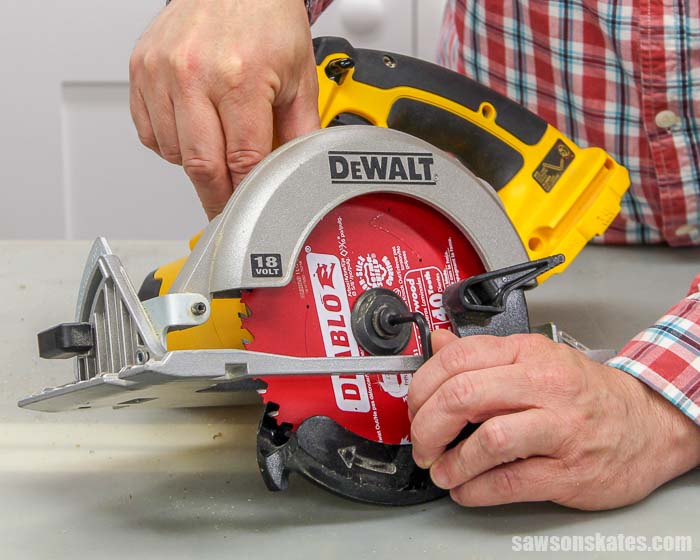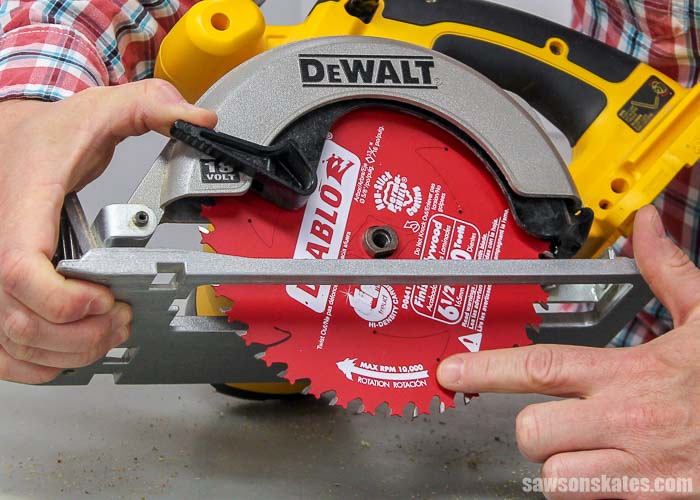If you’re curious about which way the teeth go on a circular saw blade, you’ve come to the right place! Understanding the correct orientation of the teeth on a circular saw blade is crucial for achieving smooth and efficient cuts. So, let’s dive in and unravel this mystery together!
When it comes to circular saw blades, the teeth are strategically designed to cut through various materials. But which way should they face? Well, it’s as simple as “pointing in the right direction.” Understanding the orientation of the teeth is key to optimizing your saw’s performance and ensuring your safety. So, let’s get started and unlock the secret behind the way the teeth go on a circular saw blade!
Are you ready to uncover the secret to correctly positioning the teeth on a circular saw blade? By the end of this guide, you’ll have a clear understanding and be all set to make smooth and precise cuts. So, let’s jump right in and explore the world of circular saw blades and their tooth orientation. Get ready to become a pro in no time!

Which Way Do the Teeth Go on a Circular Saw Blade?
Have you ever wondered which way the teeth on a circular saw blade should face? It may seem like a simple question, but the orientation of the teeth can significantly affect the performance and safety of your saw. In this article, we will explore the correct direction for the teeth on a circular saw blade and why it matters.
Understanding the Anatomy of a Circular Saw Blade
Before diving into the direction of the teeth, it’s important to understand the basic anatomy of a circular saw blade. A circular saw blade is typically composed of three main parts: the body, the teeth, and the gullet. The body of the blade is the circular disk that attaches to the saw. The teeth are the small, sharp protrusions around the edge of the blade that do the cutting. The gullet is the space between the teeth that allows for the removal of waste material.
Now that we have a basic understanding of the different parts of a circular saw blade, let’s move on to the direction of the teeth and how it affects the performance of the saw.
The Direction of the Teeth
The Importance of Tooth Direction
The direction of the teeth on a circular saw blade is crucial for two main reasons: cutting efficiency and safety. When the teeth are facing the wrong way, the cutting process becomes less effective, resulting in slower cuts and an increased risk of kickback. Kickback occurs when the saw blade binds in the material being cut and forcefully throws the saw back towards the user.
To determine the correct direction of the teeth on a circular saw blade, you need to look for an arrow or directional indicator on the blade itself. This arrow or indicator will point in the direction that the teeth should face. For most circular saw blades, the teeth should face forward or in the direction of rotation. This means that the tips of the teeth should be pointing towards the front of the saw.
By aligning the teeth in the correct direction, you ensure that the blade cuts smoothly and efficiently through the material, reducing strain on the saw and minimizing the risk of kickback.
Common Mistakes and Tips for Proper Alignment
While aligning the teeth in the correct direction may seem straightforward, it’s easy to make mistakes, especially if you’re new to using a circular saw. Here are some common mistakes to avoid and tips for proper alignment:
- Mistake #1: Installing the blade upside down: Make sure to install the blade with the correct side facing down. The teeth should be pointing in the direction of rotation.
- Mistake #2: Ignoring the directional indicator: Always check for the arrow or directional indicator on the blade. It is there for a reason and will guide you in properly aligning the teeth.
- Mistake #3: Not tightening the blade: Ensure that the blade is securely tightened to prevent any wobbling or movement during operation.
- Tip #1: Use the right blade for the job: Different blades are designed for specific materials and cutting applications. Choose a blade that is appropriate for your project to achieve optimal results.
- Tip #2: Follow safety precautions: Always wear appropriate safety gear, such as safety glasses and gloves, when operating a circular saw. Take the time to familiarize yourself with the saw’s safety features and guidelines for use.
Conclusion:
Knowing the correct direction for the teeth on a circular saw blade is essential for both the performance and safety of your saw. By aligning the teeth in the right direction, you can ensure smooth and efficient cuts, while minimizing the risk of kickback. Remember to always check for the directional indicator on the blade and follow the manufacturer’s guidelines for proper installation. With the right blade and proper alignment, you can tackle your cutting projects with confidence and precision.
Key Takeaways: Which Way Do the Teeth Go on a Circular Saw Blade?
- The teeth on a circular saw blade should point in the direction of rotation.
- Most circular saw blades have markings or arrows indicating the correct way to install them.
- If there are no markings, the teeth should face forward, towards the front of the saw.
- Installing the blade the wrong way can result in poor cutting performance and potential safety hazards.
- Always consult the manufacturer’s instructions or user manual for proper installation guidance.
Frequently Asked Questions
Welcome to our FAQ section on circular saw blades! Here, we provide answers to common questions about the orientation of the teeth on a circular saw blade. Read on to gain a better understanding of how the teeth are positioned for effective cutting.
1. How are the teeth positioned on a circular saw blade?
The teeth on a circular saw blade are positioned in an alternating pattern. They are angled in a way that allows for efficient cutting through various materials. As you look at the blade, you’ll notice that the teeth are pointing forward or outward from the center. This orientation ensures that the blade cuts smoothly and reduces the chance of kickback.
Some blades have a specific rotation direction indicated by an arrow. When installing the blade, it’s important to align the arrows on the blade with the direction of rotation on the saw. This ensures that the teeth are cutting in the correct direction and maximizing their cutting efficiency.
2. Can a circular saw blade be installed backwards?
No, a circular saw blade should never be installed backwards. The teeth on the blade are designed to cut in a specific direction for optimum performance and safety. By installing the blade backwards, the teeth would be cutting against the natural rotation of the saw, leading to ineffective cutting and potential hazards.
When installing a circular saw blade, always make sure to position it with the teeth facing in the correct direction according to the rotation of the saw. This ensures that the teeth engage with the material properly and deliver clean and precise cuts.
3. Is there a specific way to determine the correct orientation of the teeth?
Yes, there are a few ways to determine the correct orientation of the teeth on a circular saw blade. First, look for any markings or labels on the blade itself. Some blades may have arrows or directional indicators that show the proper installation direction. These markings should be followed to ensure the teeth are facing the right way.
If there are no markings on the blade, you can check the shape of the teeth. Typically, the teeth on a circular saw blade are designed to cut as the blade rotates in a specific direction. By examining the shape and angle of the teeth, you can determine the correct orientation based on what makes the most sense from a cutting perspective.
4. Are there any safety precautions to keep in mind when using a circular saw blade?
Absolutely! When working with a circular saw blade, it’s important to prioritize safety. Always wear appropriate protective gear, such as safety glasses and gloves, to protect yourself from any potential hazards. Additionally, make sure that the saw is properly adjusted and in good working condition before use.
Take precautions to prevent kickback, which is when the workpiece is forcibly thrown back toward the user. Keep a firm grip on the saw, position yourself correctly, and use a push stick or similar device when cutting smaller pieces. Lastly, always follow the manufacturer’s instructions and best practices for operating the circular saw to ensure a safe and successful cutting experience.
5. How often should I replace a circular saw blade?
The lifespan of a circular saw blade can vary depending on several factors, such as the type and frequency of use, the materials being cut, and the overall quality of the blade. However, as a general guideline, it is recommended to replace a circular saw blade when you notice decreased cutting performance, such as burning or tearing of the material, or when the teeth become excessively dull or damaged.
If you regularly use the circular saw for professional purposes or heavy-duty projects, you may need to replace the blade more frequently compared to occasional or light use. It’s important to regularly inspect the blade for signs of wear and tear and replace it as needed to maintain optimal cutting performance and safety.

Summary
So, when it comes to which way the teeth go on a circular saw blade, the answer is pretty simple. The teeth should always face forward or towards you when you’re using the saw. This way, the blade can cut through the material smoothly and efficiently.
Remember, safety is important. Always read the instructions and wear protective gear when using a circular saw. And now you know how to properly position the teeth on a circular saw blade!
